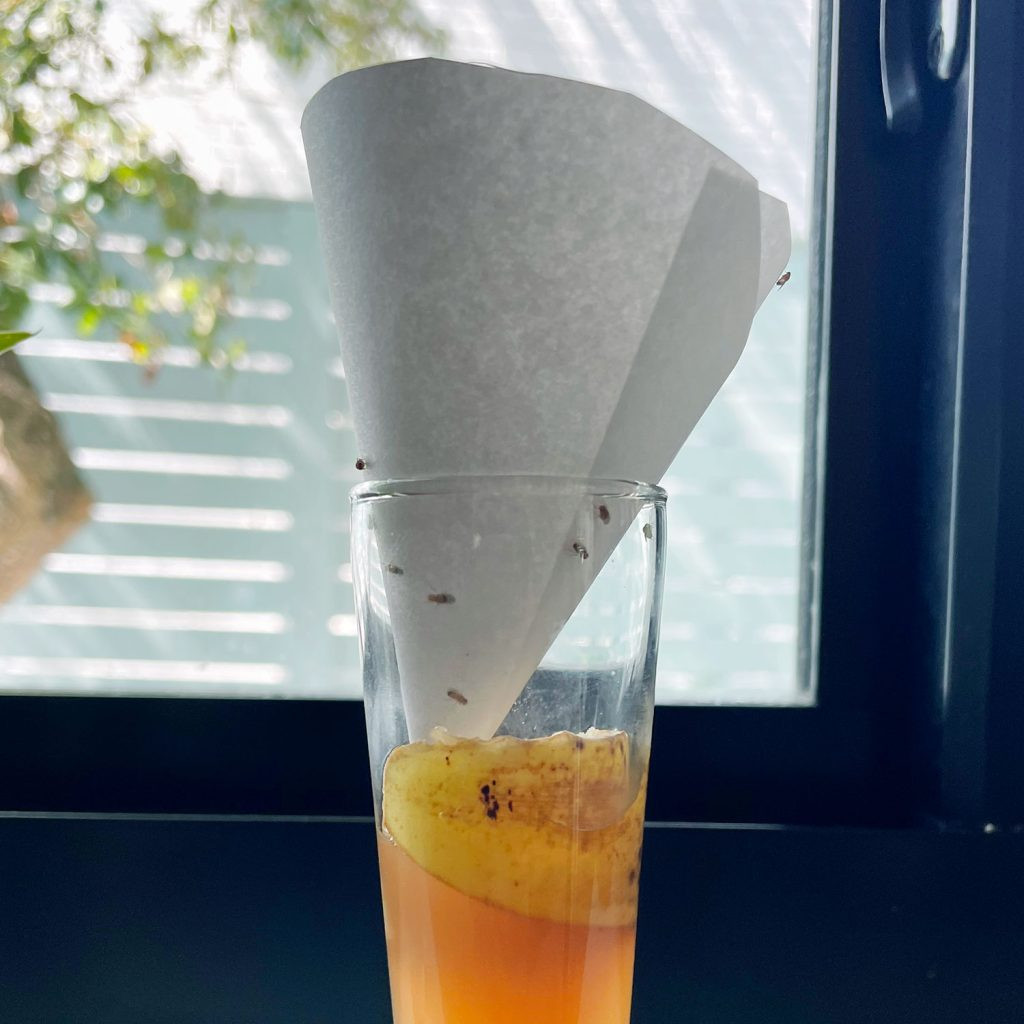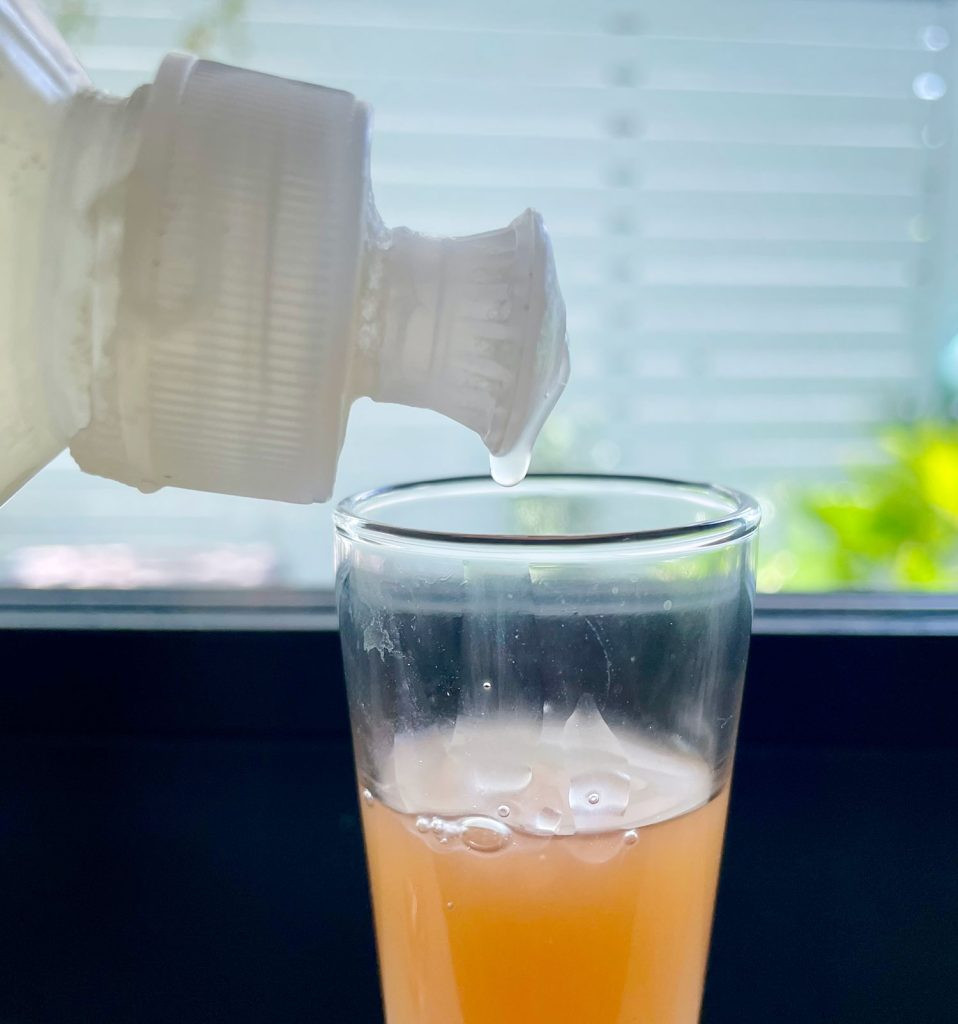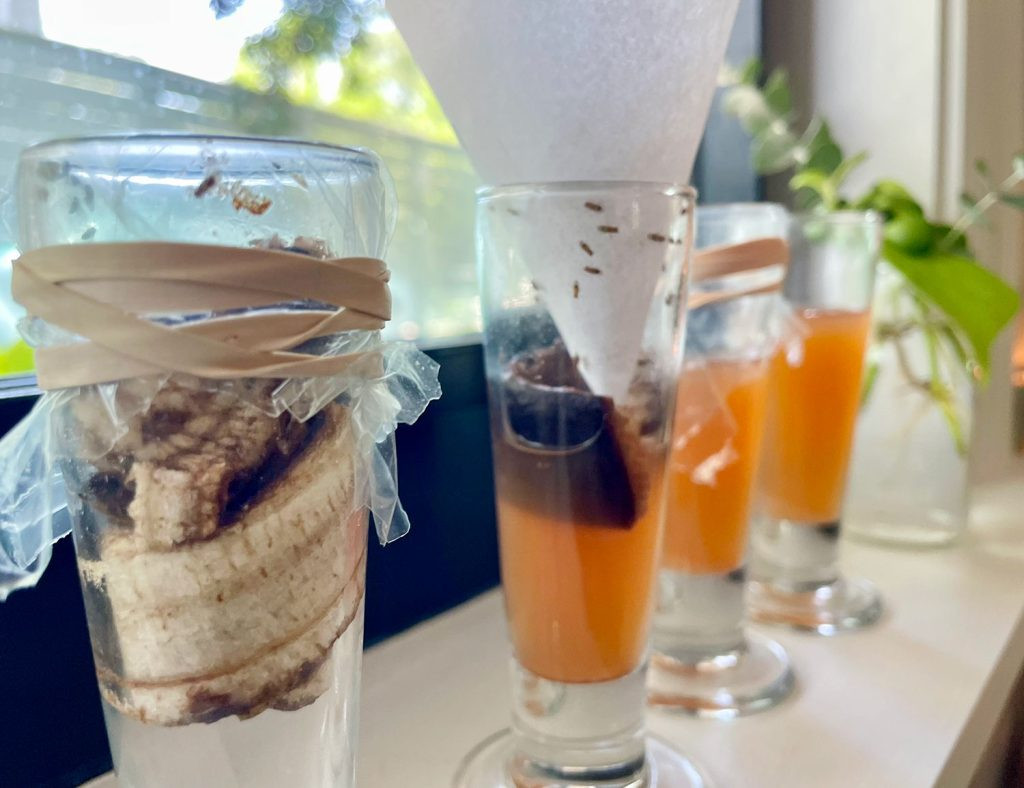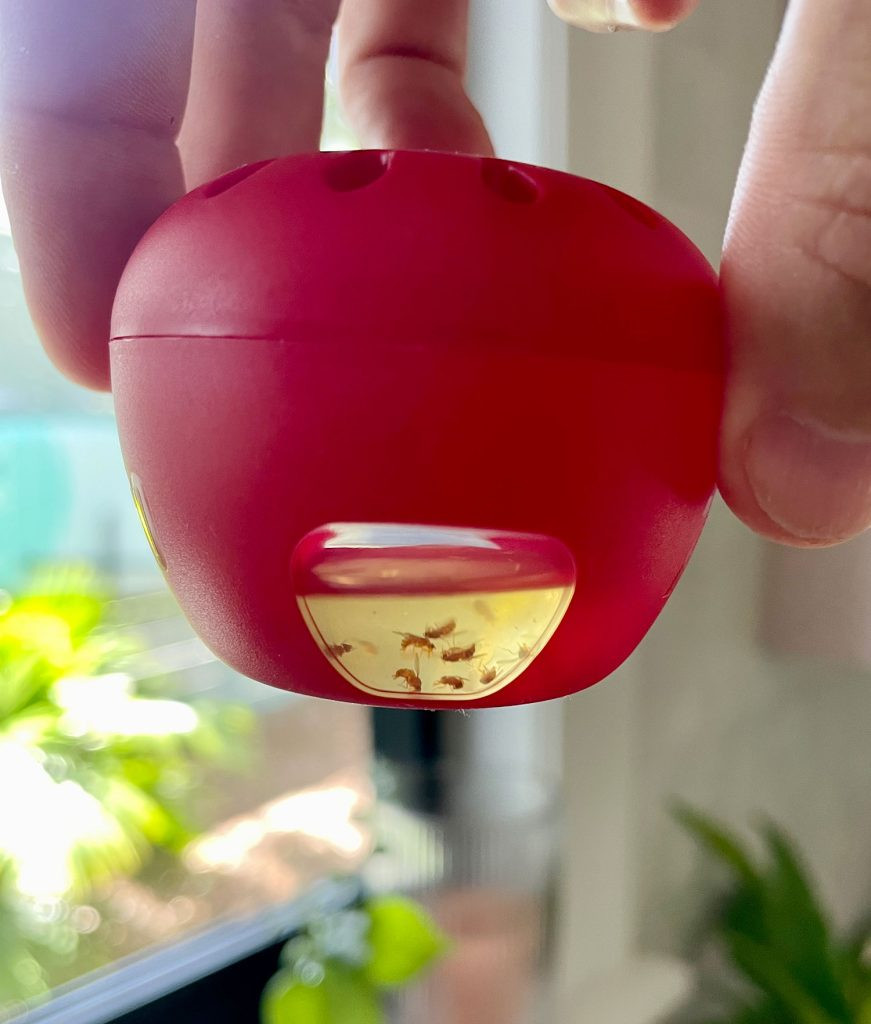Are tiny bugs buzzing around your fruit bowl or hovering near the sink? You’ve likely encountered fruit flies! These common kitchen pests are more of a nuisance than a major problem, and thankfully, eliminating them doesn’t require harsh chemicals or expensive gadgets. You can probably tackle this issue using items you already have at home.
Recently, we experienced a fruit fly invasion in our own kitchen – a rare occurrence after years in the same house, leaving us puzzled about their sudden appearance. This unexpected situation became the perfect opportunity to put various fruit fly elimination methods to the test. Extensive note-taking and even a spreadsheet were involved! Today, I’m sharing the most effective homemade fruit fly traps and simple instructions on how to make them.
These DIY traps are incredibly easy to assemble, using natural, household ingredients. They are a budget-friendly and chemical-free solution. If you’re feeling compassionate, some of these traps even offer a humane way to catch and release fruit flies outdoors. We’ll also cover essential tips to prevent future fruit fly infestations from taking hold in your kitchen.
Understanding Fruit Flies
Fruit flies are small, winged insects that, true to their name, are strongly attracted to ripe and fermenting fruits and vegetables. They also gravitate towards sugary substances and fermented drinks like beer, wine, and juice. You’ll often find them congregating around fruit bowls, garbage disposals, trash cans, and even kitchen drains. They are about the size of a grain of rice, resembling tiny, tan or brownish houseflies with distinctive red eyes. Fruit flies are most prevalent during summer and late fall, coinciding with fruit harvesting seasons.
A fruit fly problem often starts subtly, perhaps with a few individuals hitching a ride into your home on fresh produce. However, female fruit flies are prolific breeders, capable of laying hundreds of eggs in their short lifespan, with eggs hatching in as little as 12 hours. They can mature into adults within days, meaning a small initial presence can quickly escalate into a large infestation. Therefore, prompt action is crucial to eliminate fruit flies effectively.
Distinguishing Fruit Flies from Similar Pests: Fungus Gnats and Drain Flies
Fruit flies are frequently mistaken for other small flying insects commonly found indoors, particularly fungus gnats and drain flies. While all are small and winged, accurate identification is key to choosing the correct elimination method. The easiest way to tell them apart is by observing where you typically see them and what larger insect they resemble.
- Fruit flies: Look like small flies. They are found near fruit, garbage, and other food sources.
- Drain flies: Look like small, fuzzy moths. They are usually seen near sinks and drains.
- Fungus gnats: Look like small mosquitos. They are typically found around houseplants, as they breed in damp potting soil.
If you’re uncertain, trying one of the traps described below can help. If it attracts the pests in your home, you’re likely dealing with fruit flies!
4 Simple DIY Fruit Fly Trap Recipes
Getting rid of fruit flies doesn’t need to be a difficult or expensive task. All you need are some common household items and a bit of patience. Each of these traps works on the same principle: attract the fruit flies and then prevent their escape. We tested these four DIY methods and found a clear winner. Since you likely already have the necessary supplies at home, trying more than one method is easy. Think of it as a fun, mini science experiment in your kitchen! Here are the first 4 methods we experimented with:
- Funnel Trap
- Plastic Wrap Trap
- Dish Soap Trap
- Rotting Fruit Trap
I’ll provide detailed instructions for each method below, along with our findings on their effectiveness. Keep in mind that some traps work faster than others, and completely eliminating a fruit fly problem might take several days, regardless of the technique you choose.
Method 1: The Paper Funnel Fruit Fly Trap
This trap design lures fruit flies into a container through a small opening at the bottom of a paper funnel. Once inside, the flies struggle to find their way back out through the narrow opening.
 DIY Fruit Fly Trap With Paper Funnel
DIY Fruit Fly Trap With Paper Funnel
Supplies:
- Small clear jar, cup, or container (narrow opening preferred)
- Piece of paper or cardstock
- Tape
- Scissors
- Apple cider vinegar (ACV)
Instructions:
- Select a container: Choose a small, clear container like a used food jar or plastic bottle. A narrower opening is beneficial for this method.
- Add apple cider vinegar: Pour a small amount of apple cider vinegar, old beer, or wine into the container base. The enticing scent will attract the fruit flies.
- Create the funnel: Shape a piece of paper or cardstock into a cone with a very small hole at the tip. Secure the cone shape with tape. You can create the small opening by cutting the tip if it’s easier. It only needs to be about the size of a grain of rice.
- Position the funnel: Place the paper funnel into the container opening. Adjust the funnel width so it rests securely on the rim of the container without touching the liquid. Ensure it seals against the edges to prevent flies from escaping through gaps.
- Humane release (optional): Carefully carry the trap outdoors without disturbing the funnel (or flies will escape!). Remove the funnel outside to let the trapped fruit flies fly away.
While you could use a store-bought funnel, the opening might be too wide, allowing captured fruit flies to escape more easily.
Method 2: The Plastic Wrap Fruit Fly Trap
Similar to the funnel trap, this method uses the alluring scent of apple cider vinegar to draw in fruit flies. They enter the trap through tiny holes in the plastic wrap covering the container top but then struggle to escape.
Supplies:
- Small clear jar, cup, or container
- Rubber band
- Plastic wrap or plastic bag
- Toothpick
- Apple cider vinegar (ACV)
Instructions:
- Choose your container: Select a small, clear jar, cup, or glass container. Almost any size will work. Clear containers make it easier to monitor trapped flies, but even an old can will do.
- Add apple cider vinegar: Pour apple cider vinegar into your container. The smell is the attractant. Old beer or wine also work, but avoid using regular white vinegar.
- Cover with plastic wrap: Tightly stretch plastic wrap over the container opening and secure it with a rubber band. Saran wrap works well, or you can use a piece cut from a plastic bag.
- Poke small holes: Use a toothpick to carefully poke a few small holes in the plastic wrap top. You don’t need many, just enough for fruit flies to enter.
- Humane release (optional): Take the entire trap outdoors carefully without removing the plastic wrap (or flies will escape!). Then, remove the plastic wrap to release them.
Alternatively, you can create this trap using a metal jar lid. Use a mason jar or old food jar and puncture a small hole in the metal lid using a hammer and nail.
Method 3: The Dish Soap Fruit Fly Trap
Unlike the previous traps, this method doesn’t require a cover. Instead, it relies on the surface tension of soapy water to trap the pests. Note: This method isn’t designed for humane release, as the soap will coat the flies.
 Dripping Dish Soap Into Apple Cider Vinegar For DIY Fruit Fly Trap
Dripping Dish Soap Into Apple Cider Vinegar For DIY Fruit Fly Trap
Supplies:
- Small container, bowl, or dish
- Dish soap
- Apple cider vinegar (ACV)
Instructions:
- Pour apple cider vinegar: Fill the bottom of a small container, bowl, or dish with apple cider vinegar. The scent will attract fruit flies.
- Add dish soap and mix: Add several drops of dish soap to the apple cider vinegar and gently stir to mix. The soap breaks the surface tension, trapping flies that land on the liquid.
This dish soap technique can also be combined with the plastic wrap or funnel traps. Simply add dish soap to the apple cider vinegar before covering the container. This offers an additional trapping mechanism.
Method 4: The Rotting Fruit Fruit Fly Trap
We also experimented with traps that replaced apple cider vinegar with fruit, which is highly attractive to fruit flies.
Supplies:
- Small glass jar, cup, or container
- Plastic wrap or paper funnel (depending on your preferred trap style)
- Small piece of fruit, such as banana peel or apple slice
To make a rotting fruit trap, simply substitute apple cider vinegar with a piece of banana peel, apple slice, or peach in either the Plastic Wrap or Funnel trap setup. You can also add a fruit scrap to apple cider vinegar for enhanced attraction. Be sure to replace the fruit every day or two to avoid introducing unpleasant odors to your kitchen.
Determining the Most Effective Fruit Fly Trap
As you can see from our experiment photos, we tested four different DIY traps to determine which performed best. The homemade traps we compared were:
- Plastic Wrap Trap with banana peel
- Funnel Trap with ACV + banana peel
- Plastic Wrap Trap with ACV + dish soap
- Dish Soap Trap with ACV
 4 DIY Fruit Fly Traps Close Up
4 DIY Fruit Fly Traps Close Up
Our results indicated that the type of bait was more critical than the trap design itself. Traps using banana peel were significantly more effective than those using apple cider vinegar alone. The two Plastic Wrap Traps were nearly identical in design, but the one baited with banana peel captured dramatically more flies than the ACV and soap trap. Perhaps apple cider vinegar is less appealing when real fruit is nearby?
Our recommendation is to include a fruit scrap in any trap you set up! We slightly preferred the plastic wrap trap because it was easier to assemble and less prone to accidental spills. We did knock over the funnel trap once, inadvertently releasing some flies back into the kitchen – oops!
What Bait Attracts Fruit Flies Most Effectively?
This led us to further investigate which type of fruit works best as bait, extending our kitchen experiment. We tested three readily available fruits: banana peel, apple slices, and a strawberry. We placed each fruit in a separate Plastic Wrap Trap, side-by-side on the counter, for 24 hours.
While the banana peel initially seemed promising (being the ripest at the start), the fruit flies were ultimately most attracted to the strawberry. The banana peel still captured a good number of flies, but the strawberry became increasingly effective as it ripened further. Interestingly, the apple slices didn’t catch a single fruit fly!
Store-Bought Fruit Fly Trap Options
If DIY methods aren’t working for you, or if you prefer a ready-made solution, several effective store-bought fruit fly traps are available. These traps have overwhelmingly positive reviews and are typically priced under $20. They might be worth considering if you need to trap other types of flying insects or prefer a more discreet trap design.
 Collage of Storebought Fruit Fly Traps
Collage of Storebought Fruit Fly Traps
During our experiment, we purchased a pack of Terro Fruit Fly Traps to compare their performance to our homemade traps. We placed a Terro trap next to our banana and strawberry traps for 24 hours to see which performed best.
Again, our homemade strawberry trap was the most effective, followed closely by the banana peel trap. The store-bought trap only caught a single fly in that timeframe. HOWEVER…
 Terro Fruit Fly Trap With Dead Fruit Flies Visible
Terro Fruit Fly Trap With Dead Fruit Flies Visible
To ensure a fair comparison, we discarded our DIY traps and left the store-bought trap out for another 24 hours. During this extended period, it caught the significant number of flies shown above. So, the store-bought trap definitely works, just not as quickly or efficiently as our homemade traps in the initial 24-hour period. Our conclusion? Store-bought traps are a good option if you prefer a more subtle appearance, especially for long-term placement. However, homemade traps are highly effective for quickly eliminating fruit flies!
Preventing Fruit Flies in Your Kitchen
While eliminating fruit flies is relatively easy, preventing them from infesting your kitchen in the first place is even better. Here are simple preventative measures:
- Maintain clean kitchen surfaces: Regularly wipe down countertops, stovetops, tables, and any surfaces that may collect food residue or spills. Fruit flies are particularly drawn to fruit, sugary juices, and alcohol, so keep these areas clean!
- Take out trash frequently: Food scraps left in your garbage overnight can rapidly turn your trash can into a fruit fly breeding ground.
- Dispose of overripe fruit promptly: Regularly check your fruit bowl for overripe or rotting fruit (apples, bananas, etc.) and discard them before they become a problem.
- Wash fruit immediately after bringing it home: Washing produce as soon as you get home from the store can remove any fruit fly eggs or larvae that might be present (except for berries, which may spoil faster if washed immediately).
- Refrigerate produce when possible: Fruit flies don’t thrive in cold temperatures, so store fruits and vegetables in the refrigerator whenever practical.
- Clean your sink drain regularly: Food particles trapped in your drain can also attract fruit flies. Use your garbage disposal regularly and flush drains with hot water.
Finally, don’t panic if you spot fruit flies in your kitchen. While prompt action is advisable to prevent the problem from worsening, the solutions outlined here are simple, effective, and fast-acting. You might even find yourself enjoying a bit of fruit fly science in your own kitchen, just like we did!
*This post contains affiliate links, so we may earn a small commission when you make a purchase through links on our site at no additional cost to you.